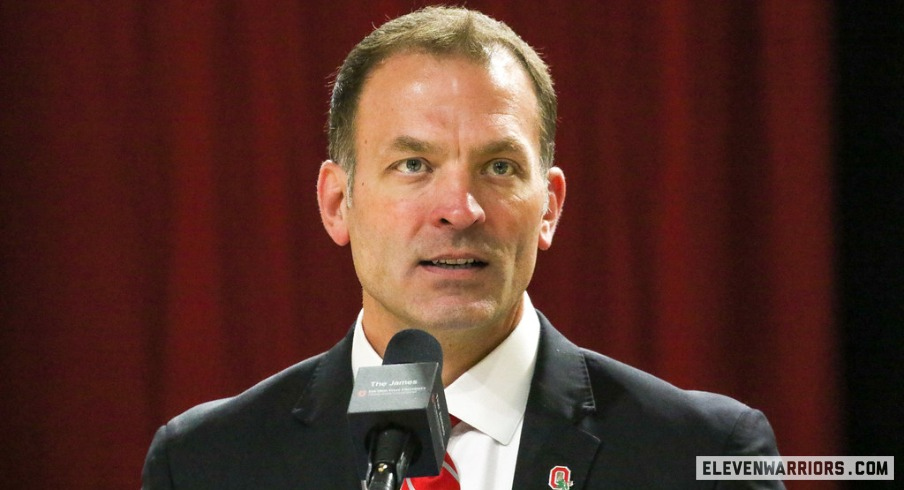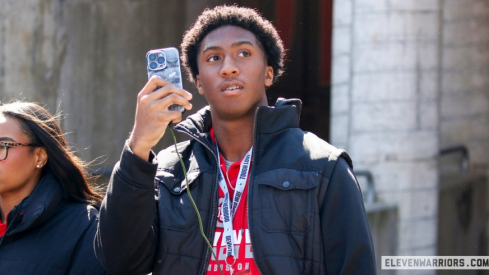During his opening statement at his introductory press conference Wednesday, soon-to-be Ohio State athletic director Ross Bjork laid out what he believes his responsibilities are as an AD.
The third item to hit his list after building culture within the athletic department and developing Buckeye coaches was fundraising, both in the NIL space and at large.
“Revenue generation, revenue acquisition, we have to embrace all of it,” Bjork said. “NIL to buying a T-shirt and everything in between is something that we will embrace heavily and we will get after it.”
Indeed, one of the biggest attractions of hiring Bjork was his ability as a fundraiser and fund manager. Texas A&M, his previous destination, had reported massive NIL coffers that helped the Aggies secure the nation’s No. 1 football recruiting class in 2022.
Bjork also saw Texas A&M pull in the seventh-most revenue nationwide in 2022, per USA TODAY. The Aggies’ athletic department generated a reported $193,139,619 that year.
It’s something Bjork will need to have Ohio State on the forefront of as the college football landscape sees heavier and heavier influence from NIL year after year with the potential for players to be paid directly in the near future.
“I needed someone that could come in and understand this ever-changing landscape of collegiate athletics,” Ohio State president Ted Carter said. “Name, image and likeness, potential revenue sharing, the changing landscape of conferences, expansion, expansion of the College Football Playoff and even NCAA structure and governance.”
Elaborating further, Carter said he’s going to lean on Bjork to advise him on important conversations and decisions related to NIL.
“Name, image and likeness, I’d say we’re still in the early stages of it,” Carter said. “We’re still learning a lot more about it. There’s gonna probably be a lot more regulations put around that. I think that will tie, eventually, to what Ross was already talking about in whatever shared revenue models that will go into the future.”
On that subject, Bjork is in full support of a player revenue-sharing model.
“We need to chart a new course for the financial arrangement, the financial agreement between the athlete and the institution,” Bjork said. “We can call that whatever we want, but that’s where we’re going. We need to recreate that model, period.”
Fundraising is something that seems to come naturally to Bjork. In his words, it’s all about people. Forming relationships and communicating both the ambitions of a given team or piece of the athletic department and what Ohio State will need in terms of support to try and reach those goals.
“It’s really not that hard,” Bjork said. “If you’re organized, if you’re accessible, if you lay out a vision, typically you don’t have to ask. The donor typically says, ‘Wow, I really like that. What do you need?’ Then there’s technical proposals and things like that, but it’s all about the relationship. Then our job is to activate their passion, whatever that might be, through discussion, through stewardship, through cultivation.”
“We need to chart a new course for the financial arrangement, the financial agreement between the athlete and the institution.”– Ross Bjork on NIL and profit-sharing
Fundraising has an increased importance in modern-day athletics, Carter said, not just due to NIL but due to the potential future profit-sharing models with athletes and conference expansion. A Big Ten conference that now spans coast-to-coast means more travel costs.
“Managing the budget, managing the future of fundraising and how we’re gonna be able to manage a program this vast and this big is gonna take some imagination,” Carter said. “It’s gonna take somebody that’s got the ability to show people what right looks like. And I believe Ross is the man to be able to do that.”
As for NIL, with the unregulated nature of collectives and the space at large, Bjork said one of the issues is knowing exactly what other programs are doing.
It’s hard to gauge the exact approach of other universities in Bjork’s eyes. So what’s important is focusing internally and ensuring that one’s own athletics office is both at the forefront of NIL and compliant with the NCAA rules that are in place.
“No one really knows what reality really is in the NIL space unless they’re on your campus and they’re turning in the contracts to your compliance office, which is a healthy part of any NIL program,” Bjork said. “So that’s reality, is what happens on your campus. We don’t really know what’s happening across the country and that’s one of the challenges that we have here.”
When it comes to managing players in regards to NIL, Bjork believes that team culture will still come first but an open dialogue will also be important.
“Team culture, team chemistry, and then there has to be a structure around NIL,” Bjork said. “The players know who’s the most valuable player. They know who’s gonna make the most money because of who they are. So if there’s structure within your organization, if there’s constant communication about value, if the coach is building culture and there’s a lot of communication, people shouldn’t have to hide around their locker room and say, ‘What’s that person getting?’”
Bjork’s grander vision is to centralize NIL dollars and other financial resources under one umbrella within the athletics office.
“Eventually what I think you’re going to see is, you’re going to see a hub within the athletic department where everything just funnels into one hub, and that may be some of the revenue that comes into that hub and it may go out,” Bjork said. “If we can build the infrastructure the right way to model this out for the future, that’s what I’ll look at. That’s what I’ll study when I get here and learn more about.”
Bjork might get a chance to start fundraising as a senior advisor in March, but his true visions will start being implemented when he takes over for Gene Smith fully as athletic director on July 1.


